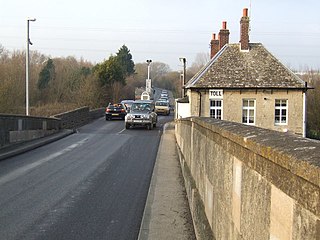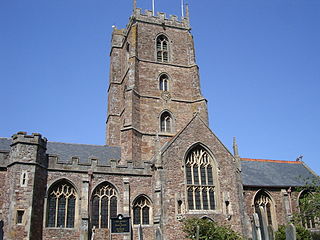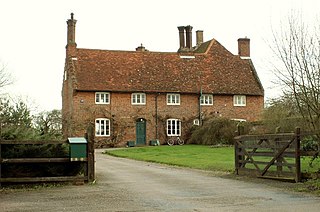Related Research Articles

Eynsham is an English village and civil parish in Oxfordshire, about 5 miles (8 km) north-west of Oxford and east of Witney. The 2011 Census recorded a parish population of 4,648. It was estimated at 5,087 in 2020.
Wallingford Priory was a Benedictine priory dedicated to the Holy Trinity in Wallingford in the English county of Berkshire.
Folkestone Priory was a pre-Reformation Benedictine monastery at Folkestone in the English county of Kent. The priory church survives as the present parish church. It was the successor to Folkestone Abbey, an Anglo-Saxon nunnery on a different site.

Swinford in the English county of Oxfordshire is a hamlet in the civil parish of Cumnor. It lies on the road between Eynsham and Farmoor (B4044) on the south bank of the River Thames. The Swinford Toll Bridge carrying the B4044 crosses the River Thames here. In 1974 it was transferred from Berkshire to the county of Oxfordshire.

Eynsham Abbey was a Benedictine monastery in Eynsham, Oxfordshire, in England between 1005 and 1538. King Æthelred allowed Æthelmær the Stout to found the abbey in 1005. There is some evidence that the abbey was built on the site of an earlier minster, probably founded in the 7th or 8th centuries. The site is a Scheduled Historic Monument.

Snelshall Priory was a Benedictine priory in Milton Keynes, Buckinghamshire in the United Kingdom, built around 1200. The priory was founded after Sybil d'Aungerville granted land at Tattenhoe to Lavendon Abbey, a Premonstratensian monastery of 'White canons' who most likely started a cell at Snelshall. This did not thrive and was abandoned about 1207. About 1219, the founder's son brought in Benedictine monks, increased the endowment and the new monastery began again. However Snelshall Priory paid 1 mark a year to Lavendon until 1232, at which point the Bishop of Lincoln decided that Snelshall owned its own lands and chapel. The priory accumulated various land through gifts, but even with all these grants, in 1321 when Henry Burghersh visited, it was so poor that "the monks scarcely had the necessities of life and had to beg even for these".
Colne Priory at Earls Colne, Essex was a Benedictine priory, initially a dependent cell of Abingdon Abbey, Berkshire. It was founded by Aubrey de Vere I and his wife Beatrice in or before 1111. Their eldest son Geoffrey had died at Abingdon about seven or eight years earlier and was buried there. On his deathbed, Geoffrey had bequeathed to Abingdon the church and lands at Kensington, Middlesex, and his parents and brothers had confirmed that grant, as had King Henry I.
Seacourt is a deserted medieval village near Botley in Oxfordshire. It was part of Berkshire until the 1974 boundary changes transferred it to Oxfordshire.

Dunster Priory was established as a Benedictine monastery around 1100 in Dunster, Somerset, England.

Winchester Cathedral Priory was a cathedral monastery attached to Winchester Cathedral, providing the clergy for the church. Cenwealh son of Cynegils is credited with constructing the Old Minster of Winchester in the 640s, and a new bishopric was created in the 660s with Wine as the first bishop. Although attacked by the Vikings in 860 and 879, the monastery survived and recovered.
Kilpeck Priory was a Benedictine priory in Kilpeck, Herefordshire, England, at grid reference SO448303.

Burford Priory is a Grade I listed country house and former priory at Burford in West Oxfordshire, England owned by Elisabeth Murdoch, daughter of Rupert Murdoch, together with Matthew Freud.

Studley Priory was a small house of Benedictine nuns, ruled by a prioress. It was founded some time before 1176 in the hamlet of Studley in what is now the village of Horton-cum-Studley, 7 miles (11 km) northeast of Oxford in Oxfordshire, England, at 1 Horton Hill Road. In 1176, the priory received a grant from Bernard of St. Walery. The nuns were unhappy to be served poor beef and new beer on Thursday and Sunday nights, and no mutton. The priory was declared closed by 1536, but appears to have experienced a brief revival before its suppression in 1539. The priory lands were sold to the Croke family. The family built the house now known as Studley Priory, which still stands in its 10 acres (4.0 ha) of grounds, in 1587; a member of the Croke family was a judge in the 1649 trial of Charles I. The house and its estate was owned by the Croke family until around 1870 when it was sold to the Henderson family, who occupied it until World War II. During the war, it was a sanatorium for Royal Air Force officers.

Hoxne Priory was a Benedictine priory at Hoxne in Suffolk, England.

Rumburgh Priory was a Benedictine priory located in the village of Rumburgh in the English county of Suffolk. The priory was founded in about 1065 as a cell of St Benet's Abbey at Hulme in Norfolk. At the time of the Domesday Book in 1086 it had 12 monks. The ownership of the priory was transferred to St Mary's Abbey in York towards the end of the 12th century. The monks of Rumburgh were particularly devoted to St. Bee, whom they commemorated at Michaelmas.
Snape Priory was a priory in Suffolk, England. It was founded as a cell of the Benedictine St John's Abbey, Colchester in Essex.
Sele Priory was a medieval monastic house in Upper Beeding, West Sussex, England.
Avebury Priory was an alien house of Benedictine monks in Wiltshire, England, between the early 12th century and the Dissolution.

Upavon Priory was a small priory in Wiltshire, England.
References
- ↑ Victoria History of Oxfordshire: Houses of Benedictine monks: the priory of Phelel(e)y
- ↑ Tom Licence, 2011: Hermits and Recluses in English Society 950-1200. Ch. 4: "How anchorites made a living." Oxford: OUP. ISBN 9780199592364
Coordinates: 51°52′41″N1°25′55″W / 51.878136°N 1.432076°W